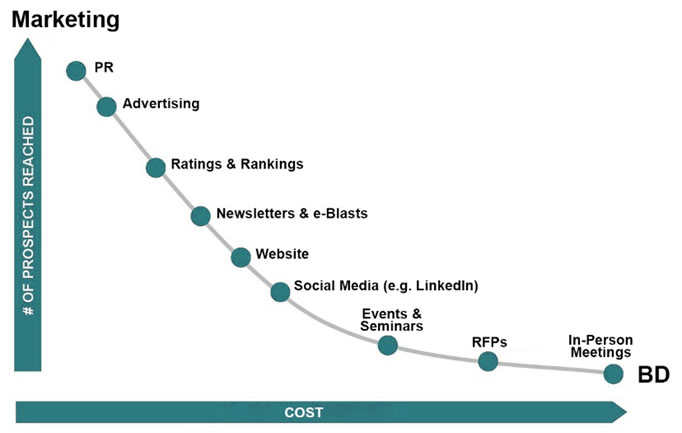Law schools are not primarily known for teaching the business of law. Similarly, CLE and other professional development programs for lawyers largely focus on the substantive practice of law rather than the set of skills it takes to build a practice or run a law firm. Future solo practitioners and law firm leaders are often left to their own devices to master skills such as accounting, human resources, practice management, realization rates, marketing and business development.
In the realm of Business Development (BD) there is an oversimplified adage that goes, “There are two kinds of lawyers: lawyers with clients; and lawyers who work for lawyers with clients.” As applied to law firms, you could say there is only one kind of law firm – a law firm with clients.
So what are some of the BD concepts that might be helpful for law firm leaders of the future?
BD and Marketing are not the same
In its 2018 Annual Marketing Partner Forum Survey, Thompson Reuters concluded that stronger BD efforts could be one way out of a flat legal market.
Back in the 1990s, when law firm marketing was building steam, the terms “Marketing” and “Business Development” were often used interchangeably. Recently, more law firms have recognized that Marketing and BD are different and should be treated differently. In its 2017 Marketing Partner Forum Survey, Thomson Reuters found that 10% of responding law firms had structurally distinct Marketing and BD departments. In the 2018 survey, that figure more than doubled to 22%.
At a basic level, “Marketing” can be defined as profile-raising activities (for a lawyer or law firm). “BD,” on the other hand, focuses on those activities that will lead to either: meaningful contact with a prospective client or obtaining additional business from an existing client. The difference between Marketing and BD is not always black & white – there are grey areas. An understanding of the interplay between the two can inform a firm on how to approach various activities. Take events for example. An event can be a pure Marketing (profile-raising) activity, or an event could have a networking component (BD). But it takes a coordinated effort to get some measureable BD impact (Return on Investment, or ROI) from an event. An event can also be a cross-selling or cross-marketing opportunity, but, again, you have to put some effort into it.

A managing partner of a law firm recently asked me, “Will we be able to show the new business we’ve received from doing this [insert Marketing activity]?” This is a legitimate question for BD activities, but less applicable to Marketing activities because ROI can be very difficult to measure on profile-raising activities. It’s rare to be able to determine that someone hired the firm because they read an article or heard an attorney speak somewhere, but it happens.
BD and Sales
Another pressing question: Can you use your non-lawyer BD professionals as the law firm’s sales force?
Much of what we know today as law firm Marketing/BD came over from the consulting profession. However, the model can vary in consulting organizations. In many consulting firms the Marketing and BD groups are completely separate – with a main role of the BD group to go on sales calls to new clients or on cross-selling missions to existing clients. The jury is still out as to whether this model could be successful at law firms. What is clear is that this approach will not work if the prospect expects to be meeting with the attorney who would be doing their work. There are other issues that are law-profession specific that need to be considered before embarking on this path, such as any applicable Rules of Ethics and the principles of attorney/client privilege.
Assuming that you (in a solo practice) or the attorneys in the law firm are the sales force, then sales training may be a good investment, and an area where a BD professional could assist.
Mailing Lists and Networks
The strength of your network (individual) or contact list (law firm) is critical to business development. That network is something that an attorney should work on at every stage of his or her career. For new attorneys, your best network may be your law-school peers – especially those who you have gotten to know and who share your interests. Three main points here are:
- As you move up in your firm or company, your peers move up in their organizations too.
- Figure out who you want to spend time with professionally, and discover activities that you both enjoy.
- Networking time is your time.
A first-year associate at a firm where I worked was actively involved in a local Big Brothers Big Sisters charitable organization. This gave her the opportunity to be one of the few of the firm’s attorneys who entertained the top contacts of a major client at a Big Brothers Big Sisters event. By getting involved in an organization that she believed in, and because she is a great representative of the firm, she got to know the key contacts, and she enhanced the clients’ overall favorable impression of the firm.
Networking comes in many forms – one of which is social media. In the professional universe, and especially the legal profession, LinkedIn is the social media networking site-of-choice (see the State of Digital & Content Marketing Survey published by Greentarget and Zeughauser Group). LinkedIn has many ways to connect, and many ways to share content with your network. There are many resources to teach lawyers how to use LinkedIn, and your BD professionals would be able to help as well, but some of the basic steps are:
- Step 1: Build a strong personal profile.
- Step 2: Build your network of connections.
- Step 3: Network to other connections via your connections.
- Step 4: Share content with your connections
One note in regard to mailing lists: Remember those firm profile-raising newsletters, e-blasts and events? Those can be turned into BD tools, but you have to put in the effort. One approach is to make sure your contacts are added to the appropriate firm mailing lists. Another approach, which I call the “Solovy” approach (after the former Chairman of Jenner & Block), is to create your own lists of contacts to whom you can personally send articles, newsletters and invitations of interest.
Chart a Course: BD Time is Your Time
In 2002 the ABA Commission on Billable Hours published a report that included what they called an “Hours Expectations/Model Diet” for associates. The diet consisted of:
- Billable client work – 1900 hours
- Pro bono work – 100 hours
- Service to the firm – 100 hours
- Client Development – 75 hours
- Training and Professional Development – 75 hours
- Service to the Profession – 50 hours
The point here is that in the mix of the 2300 hours of billable and non-billable time represented in the ABA diet – BD time is non-billable time and it is your time.
In 2012, I interviewed incoming Chicago Bar Association president Aurora Austriaco for an article in the CBA Record magazine. For the article, I asked Austriaco about work/life balance. She said half-jokingly that there is no such thing, “But if you love what you do, you can come close, with some help along the way.”
When I talk to new associates, I tell them they owe it to themselves to take control of their career. I make the analogy that managing your career is more like captaining a sailboat than a motor boat. Once you are in a firm, you will be pushed, like the wind on a sail, in a certain direction. But you have control of the tiller. You are moving in a general direction, but you can change your destination by managing how you spend your time. Professional development and CLE are your time, and you should choose those areas of the legal profession or community that you are interested in.
The same holds true for business development. You make the choices on what you do and who you spend your time with. The attorneys who have been the most successful in their practices, business development efforts and personal lives are the ones who have figured out how to blend all three.




 />i
/>i

